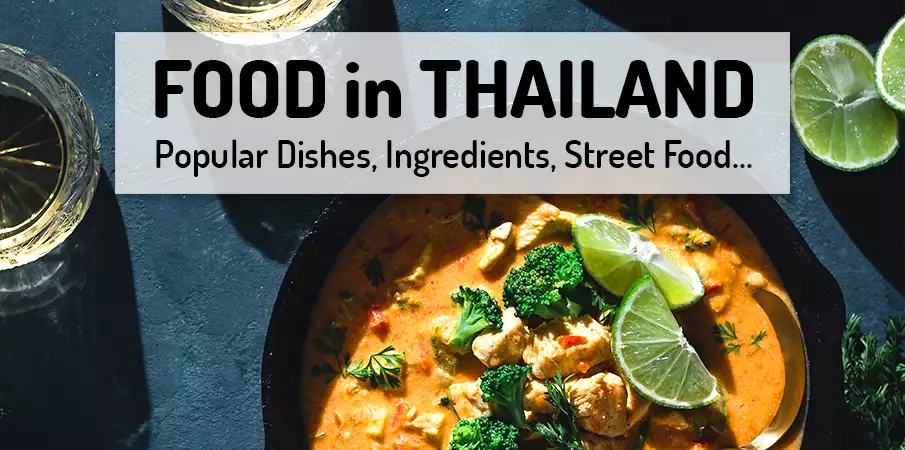
1. Diversity of Ingredients
2. Most Popular Dishes
3. Flavor Combinations
4. Regional Influences
5. Around the World
6. Explore Street Food
7. Floating Markets
8. Fruits and Vegetables
9. Spices and Additives
10. Drinks and Alcohol
11. Sweets and Desserts
Quick answer: Thai cuisine is famous for its bold flavours, fresh ingredients, and perfect balance. From fiery curries and tangy salads to sweet desserts and aromatic soups, it’s a food experience that’s spicy, sweet, sour, and salty—all in harmony. Eating in Thailand is not just a necessity—it’s a joy.
Quick overview:
- 🌶️ Flavour Profiles: A mix of spicy, sour, sweet, and salty tastes.
- 🍲 Popular Dishes: Pad Thai, Tom Yum, Green Curry, Som Tum, and Mango Sticky Rice.
- 🛒 Street Food Culture: Everywhere — from night markets to roadside vendors.
- 🍛 Curries: Coconut-based (Green, Red, Massaman) and aromatic Southern styles.
- 🥤 Beverages & Snacks: Thai iced tea, fresh fruit shakes, sticky rice, and grilled meat skewers.
- 🍽️ Eating Style: Shared dishes; meals are social and often communal.
- 🌿 Herbs & Spices: Lemongrass, galangal, kaffir lime, Thai basil, and chilies.
- 🥢 Balance: Generous use of sugar, fish sauce, lime juice, and fresh herbs for harmony.
Last updated in November 2025.
Thai Cuisine, Popular Food, Meals and Street Food.
-
- Thai cuisine boasts an incredible diversity of flavors that interweave in every bite. Its distinct characters include sweet, spicy, sour, and salty tastes that dance on the tongue like music notes. Each dish is meticulously crafted from fresh ingredients, highlighting contrasting flavors, creating an unforgettable experience.
- Masaman curry, rich in coconut milk and full of aromatic herbs, provides a combination of subtle sweetness and spicy depth. On the other hand, Tom Yum soup, based on shrimp or chicken broth, combines spicy, sour, and salty tones into a perfect symphonic experience.
Exotic Ingredients and Delicious Fresh Fruits
-
- Cuisine and dishes in Thailand also excel due to exotic ingredients that give the dishes their unique character. Galangal, similar to ginger but with a citrusy hint, kaffir lime leaves, providing a distinctive aroma, and lemongrass, bringing a refreshing citrusy touch, are just some key ingredients in Thai cuisine.
- Fruits in Thai cuisine don’t play second fiddle. Mango sticky rice, an iconic Thai dessert, combines the sweet taste of mango with sticky rice soaked in coconut milk. Or indulge in the refreshing som tam, a papaya salad with carrots, chili, and peanuts, offering an extraordinary taste experience.
Bangkok Street Culinary Adventures
-
- For those who want to experience the pulsating heart of the Thai culinary scene, there’s nothing better than exploring the streets of Bangkok – the capital of Thailand. Markets like Chatuchak offer a wide range of delicacies, from pad thai prepared right on the street to grilled shrimp skewers.
- Bangkok isn’t the only place to immerse yourself in the Thai culinary paradise. The streets of Chiang Mai are filled with small stalls offering khao soi, a traditional northern Thai noodle soup, and sai ua, spicy sausage made from meat and herbs.
Thai Cuisine and Health
-
- Believe it or not, Thai cuisine is not only delicious but also beneficial for health. Many dishes use fresh vegetables, herbs, and spices with significant medicinal properties. Fresh chili, garlic, and turmeric are not only aromatic but also contain substances with anti-inflammatory and antioxidant properties.
BOOK a TOUR / ACTIVITY in Thailand ➜
1. Diversity and Variety of Ingredients:
Diversity in Every Bite:
When you step into the world of Thai cuisine, you can’t escape the sensations of a sensual fusion of diverse flavors. Coconut milk weaves through Thai dishes, providing them with a creamy texture and a subtly sweet taste. In contrast, lemongrass adds a citrusy touch to each bite, refreshing and balancing the flavors.
Kaffir Lime and Red Curry Paste:
In their artistic rendition, Thai chefs often utilize kaffir lime, the leaves and fruits of a tree also known as the lime tree. Their aromatic essence adds a spark and a sense of exoticism to dishes. And what about red curry paste, a blend of spices, chili, and herbs that imparts richness and spiciness to Thai curry dishes.
Authentic Ingredients:
The key to achieving authentic Thai flavor is the discovery and use of real, traditional ingredients. That means boldly exploring Thai markets and stores, where you can find fresh herbs, spicy peppers, and unique spices.
Use of Fish Sauce:
Thai cuisine is incomplete without fish sauce, adding saltiness and richness of flavor. It comes from fermented fish and salt and is a fundamental building block of many Thai sauces.
Olive Touches of Fruity Notes:
Thai cuisine often surprises with its ability to combine sweetness with spiciness. Fruits like pineapple, mango, or pomegranate are not just dessert ingredients but are tastefully incorporated into savory dishes, adding an unforgettable touch.
Rise of Vegetarianism and Tofu:
With the growing interest in a healthy lifestyle and vegetarianism, tofu finds its place in Thai cuisine. It absorbs the taste and aroma of sauces and spices, creating a clever and nutritious foundation for vegetarian dishes.

2. Most Popular and Beloved Thai Dishes:
Pad Thai: Symphony of Noodles and Aromas:
Let’s begin with an icon of Thai cuisine – Pad Thai. This blend of rice noodles, shrimp, and egg filling is expertly served with peanuts, fresh bean sprouts, and lime. It’s not just a dish but a culinary spectacle representing a symphony of textures and flavors.
Tom Yum Goong: Spicy Soup to Wake Your Taste Buds:
Continuing our taste journey with Tom Yum Goong, the famous spicy soup. Shrimp, mushrooms, and herbs simmer in coconut milk, creating an unforgettable explosion of flavors that captivates with spicy and sour accents.
Green Curry: Exotic Herbs and Spices:
Countless variations of Green Curry are like a window to an exotic garden. In this blend of spices, coconut milk, and shrimp or chicken, you’ll discover a sensual fusion of herbs such as basil and cilantro, forming an unforgettable Thai poetry of flavors.
Massaman Curry: More than a Dish – a Cultural Experience:
Moving on to Massaman Curry, a dish that is not only one of the favorites but also a reflection of Thailand’s cultural heritage. In this delicate curry with slow-cooked meat, potatoes, and peanut butter, you’ll find the harmony of subtle flavors.
Som Tum: Refreshing Salad for the Taste Buds:
Thai cuisine also takes us on a journey of refreshment with Som Tum, a spicy green papaya salad. This mix of papaya, tomatoes, chili, and shrimp creates a delightful experience, like a refreshing breeze on a hot Thai day.
Khao Pad: Rice with an Unforgettable Twist:
Your culinary adventure wouldn’t be complete without Khao Pad, Thai fried rice. This dish is not just a quick solution but a perfect combination of ingredients carrying Thai creativity within.
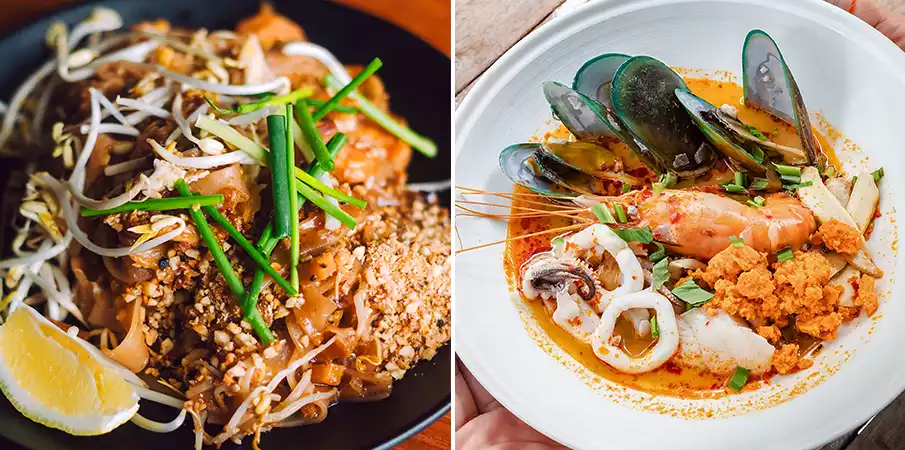
3. Mastery in Thai Flavor Combinations:
Thai cuisine is not just about handling ingredients; it is the art of blending flavors, creating a unique symphony that engages each of our senses. Mastery in flavor combinations represents the cornerstone of Thai culinary tradition, which abounds not only in exquisite dishes but also in an aesthetic experience.
Harmony of Contrasts:
Thai cuisine is known for its ability to combine seemingly incompatible flavors into one dish. Sweet mango meets spicy sauce, sour tamarind pairs with bitter lemongrass, and salty fish intertwines with spicy chilies. This harmony of contrasts creates an unforgettable impression that reaches every part of your dining experience.
Symphony of Five Tastes:
Thai cuisine pays attention to the five fundamental tastes: sweet, sour, spicy, salty, and bitter. This quintet of tastes is not a random selection but rather a precise composition aimed at stimulating every taste receptor in our mouths. Each bite is carefully balanced to take our taste buds through the entire spectrum of these flavors.
Uniqueness in Every Spell:
Thai cuisine is a mastery of adapting to local ingredients and seasonal influences. Each part of Thailand has its own treasures, and thus, each culinary tradition can boast its unique style. From the fiery Isaan salad in the northeast to the rich array of seafood on the southern beaches or islands – every region of the country adds its own note to the musical score of Thai cuisine.
Global Flagship of Taste Harmony:
Thai cuisine knows no boundaries. Its influence and popularity extend worldwide, where restaurants serve authentic Thai dishes as a symbol of exoticism and delightful indulgence. Traveling through plates full of Thai delicacies presents a virtual window into this culinary symphony that connects humanity across cultures.

4. Regional Influences in Thai Cuisine:
Thai cuisine doesn’t limit itself to the country’s borders; instead, it unfolds like a vibrant tapestry of flavors that takes you on an exciting journey of regional diversity. Each part of Thailand contributes its own cultural and culinary identity, making this exotic cuisine endlessly fascinating and ever-evolving.
Northeastern Spice: Isaan Salad and More
The northeastern Isaan region, washed by the Mekong, infuses its unique spiciness and exoticism into Thai cuisine. Isaan salad, known for its spiciness and use of fresh herbs, represents mastery in combining sour, salty, and spicy flavors. Not to be missed is the popular dish Som Tam, spicy rice balls made from rice dough, perfectly representing the taste diversity of this region.
Central Cuisine: Royal Delicacy and Rice in Every Bite
In the central part of the country, where Bangkok is located, culinary tradition becomes a blend of royal delicacy and everyday delightful living. Rice dominates every meal, whether served as a side or the main component of a dish. Tom Yum, an iconic soup full of aromatic herbs and spices, carries the essence of this region, where tradition and modernity intertwine in unique harmony.
Southern Exoticism: Seafood and Coconut Bliss
On the southern beaches of Thailand, seafood takes the lead, and coconut milk adds a creamy and exotic taste to the cuisine. Shrimp in coconut milk, beef or vegetable curry are just some of the delights that make Southern Thailand a culinary paradise. Each taste bud is awakened by a mixture of sweet, spicy, and coconut creaminess, presenting an authentic form of Thai exoticism.
Northern Traditions: Mountainous Flavors and Culture
The northern part of Thailand, surrounded by mountainous regions, brings robust and savory flavors to Thai cuisine. Khao Soi, an excellent noodle soup, is an integral part of the northern menu, containing the richness of curry, spices, and crispy fried noodles. Here, the influence of Chinese and Burmese cuisine is felt, completing the flavor palette of this regional tradition.
Eastern Sweetness: Fruits and Desserts as a Favorite Treat
The eastern part of Thailand, known for its fertile land, represents the ultimate sweetness of Thai cuisine. Fruits here reach their peak taste, and fresh coconut desserts are dangerously tempting. Mango with sticky rice or coconut pudding is just a small glimpse into this sweet oasis.
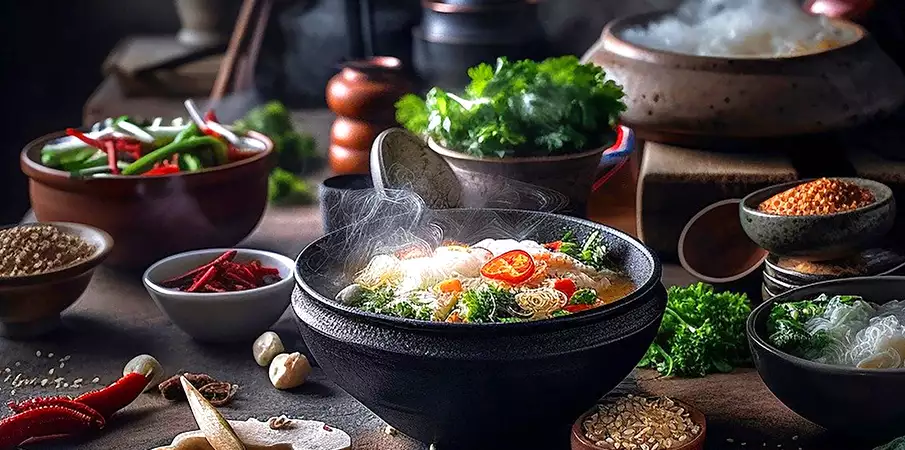
5. Thai Cuisine Around the World:
Thai cuisine is not just a gastronomic treasure in the heart of Southeast Asia; it has become a global phenomenon, winning the hearts of gourmets and exotic food enthusiasts on every continent. Its unmistakable taste and aroma know no boundaries, stirring cultural blends worldwide and bringing pieces of Thailand to every corner of the planet.
Exotic on the Plate: Authentic Delicacies Worldwide
Thai cuisine restaurants, like small windows into Thailand’s cultural heritage, are found in unexpected corners of the world. From global metropolises to small villages, food enthusiasts can taste authentic Thai dishes representing a pinnacle of exoticism and taste harmony. Pad Thai, green curry, or Tom Kha Gai – each dish is a small journey to a distant market in Bangkok or a sunny beach in Phuket.
Symbol of Exoticism: A Cuisine that Invigorates the Senses
Thai cuisine is a symbol of exoticism in the gastronomic world. Each dish is like an adventurous journey for the taste buds, where sweet, spicy, sour, salty, and bitter elements converge in unique harmony. These taste contrasts make Thai dishes an experience that not only tantalizes our taste buds but also transports us to tropical beaches, aromatic alleys of Thai markets, and the shadows of ancient temples.
Gastronomic Global Trend: Thai Cuisine’s Influence on the Cultural Scene
The influence of Thai cuisine on the cultural scene worldwide is undeniable. It’s not just about food; it’s a fashionable expression of gastronomic diversity and taste adventure. Restaurants pride themselves on offering not only traditional Thai dishes but also modern interpretations that blend tradition with innovation. Thai culinary schools and workshops shed light on the secrets of the magic of Thai flavors for people from around the world.
Cultural Exchange Through Taste: Thai Cuisine as a Bridge Between People
Thai cuisine is not just about food; it’s a bridge connecting people across cultures. A shared meal in a Thai restaurant becomes not only an opportunity to taste exotic foods but also to explore the cultural richness of Thailand. Every shared dish of rice and curry is a chance for cultural exchange, where different traditions and stories meet.
Cuisine that Inspires: From Homes to Global Culinary Trends
Thai cuisine knows no boundaries, not only in the world of restaurants but also as a source of inspiration for home cooks worldwide. Thanks to the availability of Thai ingredients and online recipes, people can easily bring the authentic taste of Thailand to their own kitchens. Thai culinary magic becomes accessible to anyone craving adventure in the culinary arts.
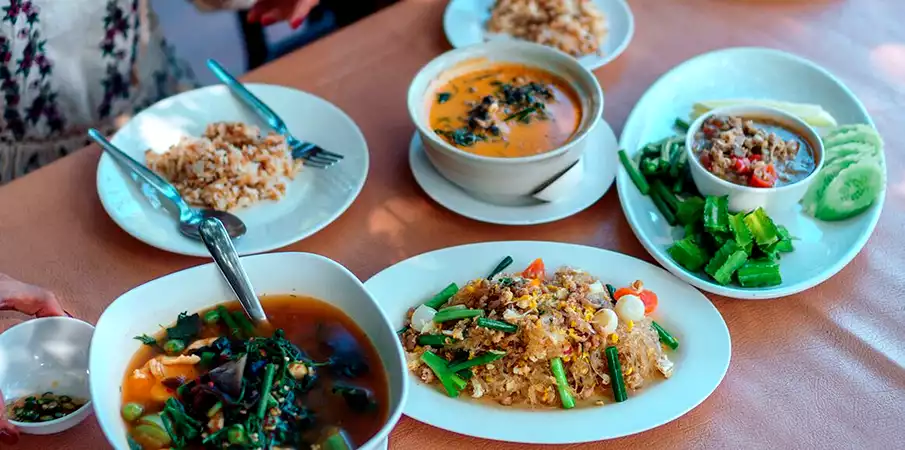
6. Explore and Discover Vibrant Thai Street Food:
Thai cuisine is not just about elegant restaurants and the comfortable shade of ancient temples; it’s also about bustling streets and street stalls, where every step becomes an adventure of taste sensations. Street food in Thailand is not merely a way of dining; it’s a culinary carnival, where every busy street becomes a stage for an unforgettable culinary journey.
Traditional Charm of Street Food:
Strolling through the streets of Bangkok, Phuket, or Chiang Mai, you find yourself in the heart of the Thai cultural pulse. The fragrant aroma from woks, vividly colored stalls, and the lively sound of sizzling on hot griddles all create an atmosphere that entices both locals and tourists for a street culinary experience.
Queen of Street Flavors: Pad Thai:
Warm conversations in the alleyways may revolve around the most famous Thai street food – Pad Thai. This classic consists of stir-fried noodles with chicken, shrimp, or tofu, sprinkled with peanuts and served with lime. Each street chef has their own secret recipe, so the taste of Pad Thai can vary from stall to stall, adding a unique experience for the taste buds.
Spicy Street Delight: Tom Yum at the Temporary Market:
Tom Yum, the iconic Thai soup, has also become a beloved street food. The preparation of this spicy delicacy happens quickly and right before the customer’s eyes, with the aroma of lemongrass, galangal, and shrimp paste wafting through the air. The traditional plastic cup becomes a portable adventure for those who want to enjoy their portion of Tom Yum at a temporary market or right on the sidewalk.
Sweet on the Street: Mango Sticky Rice:
To sweeten your street adventure, you can indulge in the popular dessert – Mango Sticky Rice. Fresh pieces of sweet mango complemented by sticky rice and drizzled with sweet coconut milk form a sweet harmonious ensemble. This street dessert attracts everyone who craves a sweet finale to their Thai culinary expedition.
From Diverse Seafood to Exotic Vegetable Varieties:
Thai street food includes not only meat and exotic seafood but also diverse vegetable dishes, such as Som Tam (vegetable salad) or Pad See Ew (stir-fried wide rice noodles with black soy sauce). The selection is truly diverse, allowing you to discover new combinations and flavors at every street corner.
Gourmet Street Food: From Stalls to Culinary Festivals:
Thai street food is not just about survival or quick refreshments. In recent years, it has evolved into a true gourmet art, where culinary masters compete for taste attention. Culinary festivals on city streets are filled with stalls offering dishes that even the most prestigious restaurants would envy.
Street Dining as a Social Experience:
Visiting a street stall in Thailand is not only about tasting delicacies but also about a social experience. People gather around the table, share different dishes, and discuss which stall has the best culinary delights. Street chefs are often known for their art and engage in conversations with their customers, adding a personal dimension to street dining.

7. Dining at Floating Markets in Thailand:
Thai cuisine is known for its endless diversity and creativity, but when we delve into the floating markets, an entirely new world of taste experiences unfolds before us. Floating markets are not just places where boats brim with exotic seafood and aromatic spices; they are also the heart of the community, where culinary skill meets tradition, and where every morsel is a small work of art.
Water Magic: Floating Markets as a Unique Culinary Phenomenon
Floating markets are synonymous with Thai cuisine and culinary adventure. This unique culinary oasis extends over the water surface, where boats sail and transport various fresh delicacies. Each floating market has its own character and offers a unique combination of dishes that reflect local traditions and the availability of seasonal ingredients.
Floating Palette of Flavors: Sampling Thailand on a Boat
Floating markets are a vibrant portrayal of Thai cultural heritage, and their diverse food offerings are like a small showcase of the Thai gastronomic paradise. Who could resist the aroma of Tom Yum soup wafting over the waterway? Or how could one forget the scent of grilled shrimp and freshly cut pineapple carried to us from boats loaded with goodies?
Fishermen-Chefs: Freshness Takes the Lead
What makes floating markets so unique is the connection between fishermen and chefs. Fishermen offer fresh fish, shrimp, and other seafood directly from their boats, and chefs then use this rich raw material to create the most delightful dishes. This means that the dishes served at floating markets are not only tasty but also full of the freshness of the sea.
Treasures from the Deep Sea:
At floating markets, you can discover treasures from the deep sea, including extraordinary fish and shellfish varieties. Grilled squid soaked in chili sauce or fish soup with coconut milk and herbs are just a small sample of what the floating markets in Thai waters have to offer.
Diversity of Markets: Roaming Among Local Delicacies
In Thailand, there are countless floating markets, each with its own atmosphere and offerings. Damnoen Saduak is one of the most famous, but it’s worth exploring smaller and less touristy markets, such as Amphawa or Taling Chan, where you can taste authentic local specialties.

8. Favorite Fruits and Vegetables in Thailand:
Traveling to Thailand is like entering a fairy-tale garden full of vividly colored and fragrant fruits and vegetables. Thai cuisine draws us into the world of exotic taste experiences, and amid it all, fruits and vegetables are the true heroes of this culinary fairy tale. For tourists, exploring the Thai kingdom of fruits and vegetables is not only a taste adventure but also a path to understanding the richness of the local culture.
Mango – the King of Fruits:
Let’s start with the king of Thai fruits – the mango. If you have the chance to visit Thailand during mango season (from March to June), don’t hesitate. Mango here is not just a fruit; it is a culinary artifact found in desserts, salads, and main dishes. The sweetness of mango perfectly complements the slightly spicy and salty flavors of Thai cuisine.
Durian – the King of Smell:
And what about durian? Often called the „king of smell,“ it has a reputation for a wild mix of intense aromas and flavors. Locals love it, but for many tourists, it can be challenging due to its strong odor. Durian is banned in many hotels and public spaces, but if you have the courage, you should definitely taste it. It has a soft and creamy flesh that can be either loved or rejected.
Rambutan – Exotic Little Ball:
Moving on to less controversial fruit, we find rambutan. This small fruit with red hairs is not only delicious but also visually appealing. Its sweet and juicy taste resembles grapes, but with a slight acidity. Rambutan is commonly found in markets across Thailand and is a favorite adventure for the taste buds of tourists.
Litchi – Fruit of the Chinese Lychee Tree:
Chinese lychee, also known as sweet lychee, is the only representative of the lychee genus (Litchi) in the soapberry family. Its fruit is known as lychee. Fragile, sweet, and juicy, lychee is a favorite treat in East Asia. It is often served as a refreshing delicacy in warm Thai markets. It should be on the tasting list when visiting during its ripening period.
Dragon Fruit – Pitahaya:
Taking us more profoundly into the magical world of Thai fruits is dragon fruit, also known as pitahaya. With its striking pink or yellow exterior and white or red flesh with delicate seeds, dragon fruit is not only tasty but visually stunning. Its sweet taste with a light acidity is ideal for refreshment during hot Thai days.
Vegetables – Colors and Taste Harmony:
Shifting to the vegetable side, we must appreciate the diversity that Thai cuisine offers. From bold basil, providing a distinctive taste to Thai curries, to delicate and refreshing shrimp or okra, which appears in the popular dish Pad Krapow, Thai vegetables are the foundation for many culinary masterpieces.
Som Tam – Salad with Nepalese Cheese:
Som Tam is a beloved salad that carries a sparkling mix of vegetables. The most well-known variation is Som Tam Thai, which includes raw green papaya, chili, garlic, tomatoes, beans, and peanuts. It is a taste experience driven by spicy, salty, sweet, and sour harmony.
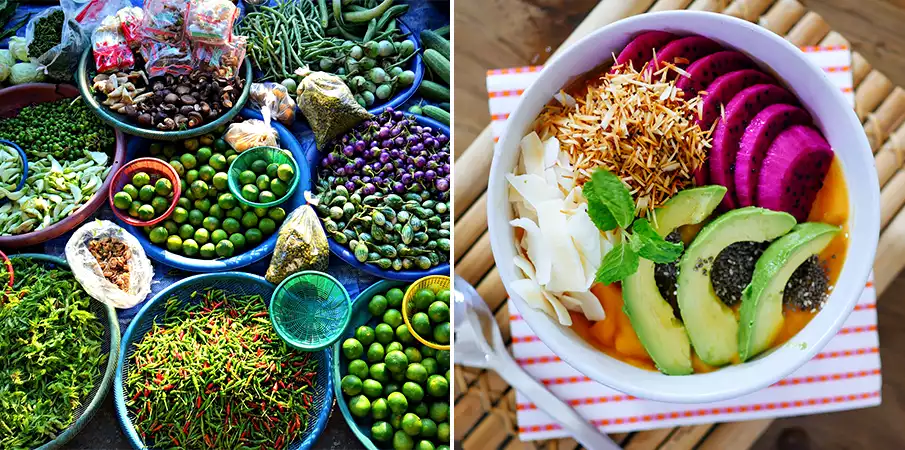
9. Thai Spices and Ingredients: A Flavor Explosion.
When we say „Thai cuisine,“ it brings to mind not only exotic dishes and diverse flavors but also an explosion of spices that gives Thai cuisine its unforgettable taste. Thai spices are not just ingredients; they are an artistic addition through which Thai chefs create their masterpieces on the plate.
Kaffir Lime Leaves:
Let’s start with kaffir lime, whose leaves give Thai dishes a unique lemony aroma. Adding these aromatic leaves to curries, soups, or sauces imparts freshness and intensity to the dishes.
Galangal:
Galangal, a relative of ginger, brings a distinctive spicy flavor to Thai recipes. Its similarity to ginger is apparent, but galangal has a more pronounced, spicy taste, which is a key element in the famous tom kha gai (chicken coconut soup).
Lemongrass:
Lemongrass is another Thai secret. Its fresh, lemony taste is an essential part of soups, sauces, and marinades, adding a touch of freshness to the dishes.
Thai Chili:
When we say Thai chili, we mean small but intensely spicy grains that add not only intense heat but also rich flavor to the food.
Shrimp Paste:
Shrimp paste, called „gapi“ in Thai, is a key seasoning for making Thai sauces and curries. Its rich and salty taste pushes the flavor boundaries, giving the dishes an authentic touch.
Coriander:
Coriander, often found in Thai cuisine in the form of finely chopped leaves or roots, provides a gentle, herbaceous taste to the food. It is a key element in Thai salads and curries.
Basil:
Basil, especially Thai holy basil, gives a distinctive taste to the food. It is an integral part of dishes like Pad Krapow and various sauces.
Coriander Roots:
Coriander roots, often overlooked, play an important role in Thai cuisine. They are an excellent way to add depth and richness of flavor to sauces and soups.
Fish Sauce:
Fish sauce, called „nam pla,“ is an essential component of many Thai recipes. Its salty, spicy taste not only adds saltiness to the dishes but also brings out umami.
Cumin:
Cumin is a spice that adds earthy aroma and subtle spiciness to Thai curries and marinades. Its use enlivens the senses and gives the food a rich flavor profile.
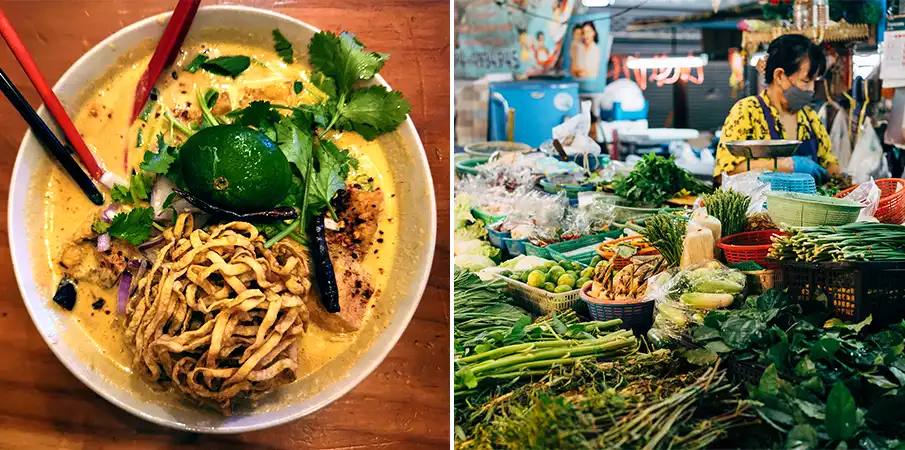
10. Popular Drinks and Alcohol in Thailand:
When you step into the world of Thai beverages, you open the doors to a vibrant realm of flavors and traditions associated with alcohol. In Thailand, drinks go beyond exotic fruit juices; they are true works of art reflecting the rich culture of the country. From traditional Thai beer to strong and aromatic Thai whiskey, each drink in Thailand serves as a guide through a delightful map of taste adventures.
Singha Beer – delightful brewing tradition:
Let’s begin with the icon of Thai beer – Singha. This light beer, named after the mythological lion adorning its labels, is a symbol of brewing tradition in the country. Light, refreshing, and with a subtle hoppy note, Singha beer is ideal for cooling off during hot days in Thailand. For beer enthusiasts, visiting local pubs to enjoy a chilled shot of Singha is an integral part of Thai drinking.
Chang Beer:
Another gem in the realm of Thai beer is Chang. Slogans like „Chang Beer, be my guest,“ or „Elephant Brand“ associate this beer with Thai heritage and culture. Chang beer is known for its bolder flavor and prominent presence on Thai dining scenes. In Thai bars and restaurants, this delightful beverage becomes an integral part of social gatherings and celebrations.
Mekhong – Thai whiskey distillate:
If you are looking for stronger magic, you cannot miss Mekhong, the Thai whiskey. This distillate gained popularity due to its unique blend of spicy flavor and sweet aroma acquired during aging in oak barrels. Mekhong is not just a drink; it is a part of Thai culture blending with the scents of the streets and the lights of the city night markets. Locals have embraced it, and it’s no wonder that tourists often get drawn into its charm.
Thai Rice Whiskey – unique art of distillation:
Thai rice whiskey, also known as „Lao Khao,“ presents a different dimension of Thai alcohol. Made in the traditional distillation method, this strong and inexpensive spirit is popular among locals, considering it a reliable companion for occasions ranging from joyful celebrations to casual gatherings with friends. While the taste might be a challenge for some tourists, it provides an authentic insight into traditional Thai drinking.
Rum Cocktails – beachy enchantment:
If you crave something sweet, Thai beaches and summer parties are home to a variety of rum cocktails. From the famous Mai Tai to the magical Pinacolada, Thai bartenders excel at creating drinks that not only refresh but also immerse you in the enchanting atmosphere of Thai beaches.
Thai Teas – tranquility and harmony:
In addition to alcohol, various types of teas are part of Thai beverages. Thai tea is known for its delicate taste and aromatic properties. Spiced masala tea, refreshing tamarind tea, or sweet and creamy Thai iced tea are among the favorite drinks complementing the taste palette of Thai cuisine.
Thai Lemonades – refreshing citrus ecstasy:
And what about those refreshing Thai lemonades? When you desire something non-alcoholic, Thai lemonades are an excellent choice. They harness the richness of local citrus fruits like lime, lemon, or kalamondin, blending them with sugar and ice, often with a touch of mint leaves for extra freshness. These drinks swing between sweetness and acidity, offering an ideal way to cool your taste buds in the hot Thai climate.
Thai Coffee: exotic aromatic symphony in a cup
Thai coffee, known as „Oliang,“ is a unique dancer of taste buds. With coarsely ground beans, the harmony of cardamom, and a rich palette of additives, it creates an aromatic symphony that stirs the senses. Enjoy the exotic taste that balances strong body with a hint of sweetness and a nod to Thai culinary tradition.
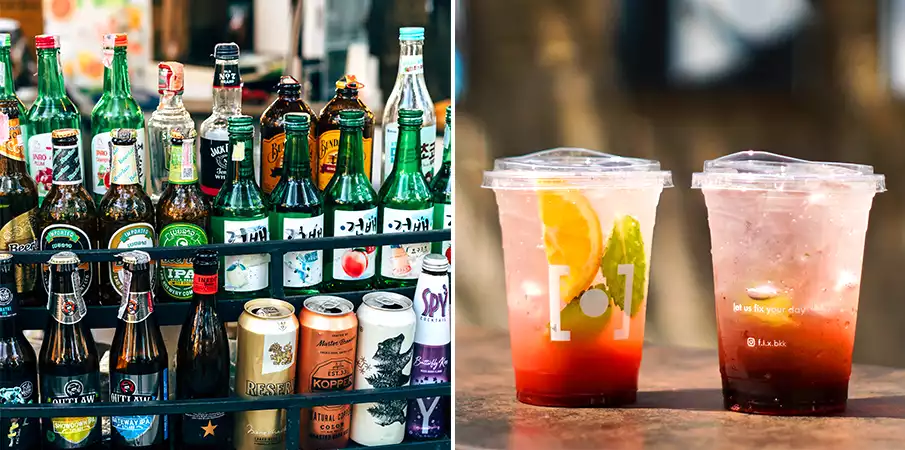
11. Popular Sweets and Desserts in Thailand:
Thai cuisine is known worldwide for its unique combination of flavors and aromas. Among the most praised parts of this culinary palette are undoubtedly the sweets and desserts. Thai treats are not only about bold flavors but also about aesthetically appealing presentation, adding the right dose of exoticism to each dessert.
-
- 1. Sticky Rice with Mango (Khao Niew Mamuang): One of the most beloved Thai desserts is Sticky Rice with Mango, also known as „Khao Niew Mamuang.“ This refreshing dish consists of slices of sweet mango served with sticky rice and drizzled with coconut milk. It is a favorite not only among locals but also among tourists. The sweet taste of mango contrasts with the creamy texture of rice and coconut milk, creating a harmonious symphony of flavors.
- 2. Banana Fritters (Kluay Tod): For lovers of crispy delights, the ideal choice is the Thai dessert called Banana Fritters or „Kluay Tod.“ Banana pieces are coated in a light batter and fried to golden crispiness. They are served with honey or condensed milk, creating a simple but irresistible experience for sweet taste buds.
- 3. Luk Chup: For those who appreciate craftsmanship and artistry in the kitchen, there’s nothing better than the traditional Thai dessert Luk Chup. It consists of small balls made from beans, coconut milk, and sugar, molded to resemble various fruits. These small „fruit“ balls are often presented in silver or gold boxes, offering not only a delicious but visually impressive experience.
- 4. Thai Banana Pudding (Khanom Kluay): Khanom Kluay is a Thai banana pudding that has won the hearts of dessert lovers worldwide. This dish combines the distinctive taste of ripe bananas with the gentle sweetness of rice flour and coconut milk. It is served in small cups and is often garnished with a layer of sesame seeds for extra crunch.
- 5. Sticky Rice with Mango and Black Sesame (Khao Niew Mamuang): Another delightful variation of sticky rice dessert is Sticky Rice with Mango and Black Sesame. This version adds a spicy touch of black sesame to the traditional Sticky Rice with Mango recipe, providing an interesting contrasting flavor and visual effect.
Thai sweets and desserts are undoubtedly an integral part of Thai culture and gastronomy. Their diversity and unique flavor combinations attract anyone with a taste for exploring Thai cuisine beyond traditional dishes. Whether in the alleys of Bangkok markets or in elegant restaurants, Thai sweets will offer you an unforgettable experience full of exoticism and delicious flavors.
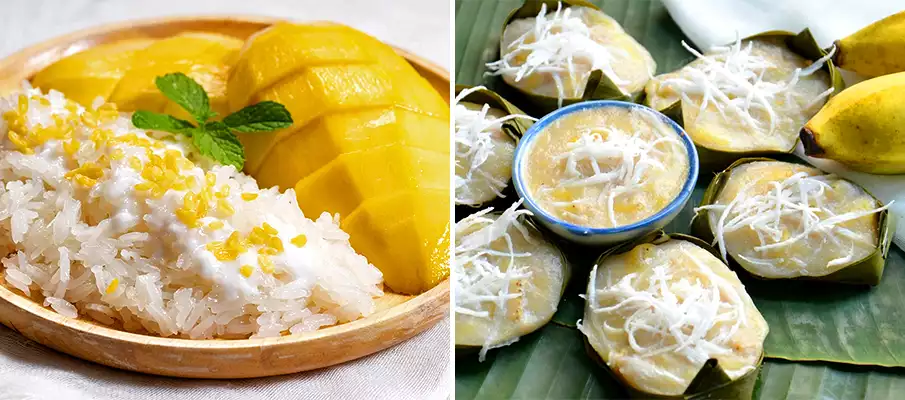
10 Most Popular Dishes in Thailand Among Tourists:
1. Pad Thai (Stir-Fried Noodles):
Pad Thai, a symbol of Thai cuisine, represents a perfect harmony of sweet, salty, and spicy flavors. It’s a stir-fried noodle dish with shrimp, chicken or tofu, vegetables, peanuts, and fresh lime juice, garnished with cilantro. This traditional delight entices tourists with its refreshing and spicy experience.
2. Tom Yum Goong (Spicy Shrimp Soup):
Tom Yum Goong, a spicy shrimp soup, is a delightful blend of shrimp, mushrooms, herbs, and a hint of chili. With intense taste and aroma, this Thai dish is for those seeking an explosion of flavors and a distinctive aroma.
3. Green Curry:
Green Curry combines green curry paste with coconut milk, meat (often chicken or shrimp), and seasonal vegetables. This curry offers a rich taste and creamy consistency, perfect for those who enjoy indulging in spicy delights.
4. Som Tum (Green Papaya Salad):
Som Tum, a green papaya salad with carrots, tomatoes, bean sprouts, and peanuts, is a refreshing dish with a spicy kick. The delicately balanced combination of sweetness and sourness creates a flavorful experience for lovers of light and spicy dishes.
5. Massaman Curry (Red Curry):
Massaman Curry is a rich and mildly sweet dish that combines curry with meat, potatoes, peanuts, and coconut milk. Its gentle and sweet taste introduces a different dimension to Thai cuisine.
6. Khao Pad (Fried Rice Dish):
Khao Pad, or fried rice, is a tradition of stir-fried rice with meat, vegetables, eggs, and pieces of pineapple or shrimp. It’s a light and tasty dish, ideal for those who want to enjoy an authentic Thai rice treat.
7. Gaeng Daeng (Red Curry):
Gaeng Daeng, red curry, offers a subtly spiced soup with meat (often beef or chicken), bamboo shoots, and herbs. It is a favorite dish for those who love stronger flavors and aromas.
8. Pad Krapow Moo Saap (Stir-Fried Minced Pork with Basil):
This popular street food combines stir-fried minced pork with garlic, chili, and basil, served with rice and a fried egg on top. It’s a simple yet richly spiced dish.
9. Kao Soi (Northern Thai Noodles):
Kao Soi is a northern Thai dish that combines soup with egg noodles and meat, usually chicken or beef. It is known for its rich taste and crispy noodles, ideal for those looking for Thai food with a unique flavor profile.
10. Mango Sticky Rice:
For a sweet ending, many tourists opt for Mango Sticky Rice, a dessert consisting of sticky rice drizzled with coconut milk and served with slices of ripe mango. Its simplicity and the rich taste of mango sweetness make it irresistible for lovers of sweet treats.
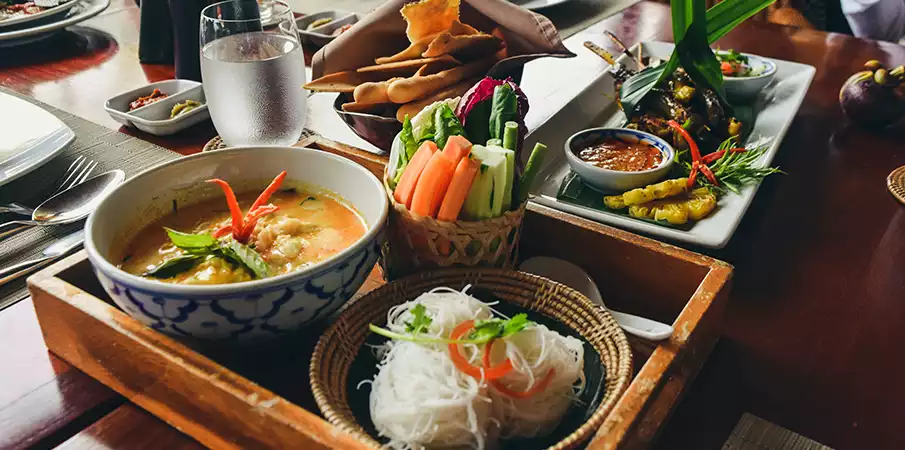
❓ FAQ + TIPS – Thai Cuisine, Food and Dining:
1. What is the significance of Thai cuisine in Thai culture?
-
- Thai cuisine is not just a way of eating but also a crucial element of Thai culture. Each dish is tied to traditions, flavors, and communal sharing, reflecting Thailand’s rich cultural diversity.
2. What are the key flavors in Thai cuisine?
-
- Thai cuisine is known for the harmony of five main flavors: sweet, salty, sour, spicy, and bitter. These flavors are combined to create balanced and rich taste experiences in most dishes.
3. What is the significance of street food markets in Thailand?
-
- Street food markets are the heart of Thai cuisine. They offer not only delicious foods but also social gatherings and an authentic look into local culture. At these markets, you can taste various delights, including Pad Thai, Som Tum, and meat or vegetarian dishes.
4. Which foods are considered Thai specialties?
-
- Thai specialties include dishes like Pad Thai, Tom Yum, Green Curry, and Mango Sticky Rice. They are popular for their rich flavors, fresh ingredients, and unique combinations of spices and herbs.
5. How do regional cuisines in Thailand differ?
-
- Regional differences in Thai cuisine reflect geographic, cultural, and historical influences. For example, in the northern part, dishes are often seasoned with mountain herbs, while the southern part features seafood and exotic spices. These differences contribute to the richness and diversity of Thai cuisine.
6. What are typical ingredients used in Thai cuisine?
-
- Typical ingredients include coconut milk, lemongrass, chili, lime leaves, and fish sauce. These ingredients add richness, aroma, and complexity of flavors to the dishes.
7. What is the significance of curry in Thai cuisine?
-
- Curry plays a crucial role in Thai cuisine. There are various types of curry, such as green, red, and yellow. Each type has its distinctive blend of spices, bringing a unique taste experience.
8. How does Thai food adapt to vegetarian and vegan diets?
-
- Thai cuisine is flexible and adaptable. Many dishes can be modified for vegetarians and vegans. Alternatively, tofu, vegetable meat substitutes, and special sauces can be used.
9. What is the role of rice in Thai cuisine?
-
- Rice is a fundamental part of Thai cuisine and plays a key role in most dishes. Popular types of rice include jasmine rice, sticky rice, and black rice. Rice complements the flavor profiles and textures of the dishes.
10. What is the significance of desserts in Thai cuisine?
-
- Desserts in Thai cuisine are a favorite indulgence. Mango Sticky Rice, Banana Pudding, and Coconut Ice Cream are just some of the popular sweets that provide a refreshing and sweet conclusion to a meal.
11. How is traditional Thai cooking passed down from generation to generation?
-
- Traditional Thai cooking is often passed down from generation to generation. Families share recipes, techniques, and culinary secrets. This not only preserves flavors but also strengthens family bonds and community.
12. What are typical methods for preparing dishes in Thai cuisine?
-
- Preparing Thai dishes often involves a combination of boiling, frying, grilling, and using fresh herbs and spices. Quick preparation, fresh ingredients, and emphasis on balanced flavors are key elements of Thai culinary tradition.
13. How does street food become an integral part of Thai dining?
-
- Street food is an integral part of Thai dining, offering an authentic view of the local culinary scene. Favorite street food delights include Pad Thai, Som Tum (green papaya salad), satay, and Kuay Teow (delicious noodle soup).
BOOK a TOUR / ACTIVITY in Thailand ➜
| 10 Important Facts about Thai Cuisine: | Description |
|---|---|
| 1. Diverse Flavor Palette: |
Thai cuisine is famous for its immensely diverse flavor palette, providing a unique experience with every bite. It unveils the secrets of combining sweetness from palm sugar, sourness from tamarind, spiciness from chili, and saltiness from fish sauce, creating a unique harmony of flavors. |
| 2. Key Role of Rice: |
Rice is an integral part of Thai cuisine and plays a key role in all aspects of dining. Rice is not just a staple grain but rather a cornerstone of everyday life. Each rice variety, from jasmine to sticky rice, has its unique characteristics and uses in preparing various dishes. |
| 3. Use of Fresh Herbs and Spices: |
Thai cuisine excels in using fresh herbs and spices that give dishes an incomparable taste and aroma. Cilantro, lemongrass, basil, and galangal are some of the basic ingredients that form the aromatic and spicy palette of Thai dishes. |
| 4. Traditional Soups – Tom Yum: |
Tom Yum, the most famous of Thai soups, is the true symbol of perfect taste fusion. This soup is an artistic creation where spicy chili meets the sourness of cherry tomatoes, the sweetness of coconut milk, and the aroma of kaffir lime. Each spoonful is a journey into the diversity of Thai flavors. |
| 5. Market Tastes – Som Tum: |
Street stalls in Thai cities offer a wide range of delicious street food, with Som Tum standing out. This spicy vegetable salad mix, made from fresh green papaya, chili, garlic, and peanuts, is a refreshing and crispy experience you shouldn’t miss. |
| 6. Sweet Desserts – Mango with Sticky Rice: |
One of the most beloved Thai desserts, mango with sticky rice, is a symbol of sweet indulgence. Mango, ripened under the hot tropical sun, is combined with sticky rice soaked in coconut milk, creating a perfect blend of creaminess, sweetness, and exoticism. |
| 7. Use of Coconut Milk: |
Coconut milk is a fundamental element in many Thai dishes. Its smooth texture and creamy taste provide a unique base for soups, curries, and sweet desserts. Coconut milk is also a key element in creating harmony in spicy and sweet combinations in Thai cuisine. |
| 8. Popular Curry Dishes: |
Thai cuisine is known for its diverse curry dishes that bring a flavorful experience full of spicy intensity and rich coconut milk aroma. From shrimp to chicken, vegetarian to meaty variations – Thai curries are a masterpiece of spice, herbs, and sauces combination. |
| 9. Fish Sauce and Fermented Ingredients: |
Fish sauce, soy sauce, and fermented pastes are among the secret ingredients that give Thai dishes their unique taste. The salty, spicy, and complex flavors of these ingredients create a signature touch that adorns each dish, adding authenticity. |
| 10. Street Food Culture: |
Immerse yourself in the vibrant energy of Thai street food culture, where various tastes and aromas meet. The streets are filled with crispy, aromatic, and juicy dishes – from fresh seafood to crispy chicken wings. Thai street stalls are a gastronomic adventure where each dish is like a small taste symphony in an open kitchen. |
Food / Cuisine in Laos|Food / Cuisine in Cambodia|Food in Malaysia|Money / Currency in Laos|Money / Currency in Cambodia|Prices in Laos





